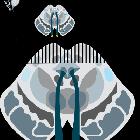Argyll-Robertson-Zeichen
Argyll Robertson pupil is usually bilateral and presents as bilaterally miotic and irregular pupils, which constrict briskly with accommodation but do not react to bright light therefore displaying light-near dissociation .
It is a highly specific sign of late neurosyphilis, however can also occur in diabetic neuropathy, multiple sclerosis, alcoholic midbrain degeneration, and stroke . When seen in these non-syphilitic etiologies, the pupil is termed 'pseudo-Argyll Robertson pupil' . The exact anatomical lesion behind this phenomenon is unknown but is thought to be caused by bilateral damage of the pretectal nuclei in the midbrain.
History and etymology
Named after Douglas Argyll Robertson (1837–1909), a Scottish surgeon and ophthalmologist, who first described this condition in mid-1860s in patients with neurosyphilis.
Argyll Robertson pupils are also sometimes called "prostitute's pupils" because of their association with late neurosyphilis. Conveniently, a popular mnemonic to remember Argyll Robertson pupils is that, just like prostitutes, they "accommodate but do not react".
Siehe auch:

 Assoziationen und Differentialdiagnosen zu Argyll-Robertson-Zeichen:
Assoziationen und Differentialdiagnosen zu Argyll-Robertson-Zeichen:
